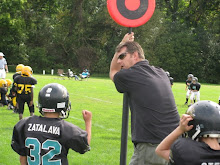In my own experience with distance learning I have come up a couple of personal definitions and have also learned a few textbook definitions over the course of the last five years. However, since the realm of distance learning is constantly evolving so to should the definitions, be based on personal experience or observation or even accepted textbook definitions. I believe distance learning is and always will evolve as technology continues to improve. Who knows, distance learning might even become a virtual 3-D experience like you would see on the holodeck of the Starship Enterprise.
In the past I would strictly describe distance learning only as “online” coursework, utilizing the internet or some form of intranet, in order to garner some required knowledge as an employee or as a student in a collegiate endeavor. As a high school teacher I have witnessed distance learning in my school applied as a means of credit recovery for those students that have not performed well in a traditional classroom, specifically to insure the student another avenue to a high school diploma, while not dropping out of school. Forming another part of my personal definition of distance learning, in the past (prior to me starting my Masters degree online) I knew people who worked toward advanced degrees through online programs or hybrid programs. This avenue provided (as it does me) greater flexibility around family and occupational obligations, as well as the restrictive nature of not being close to a physical institution of higher learning. My perception of distance learning has been influenced by what I have witnessed, but as I work in my own program of MS in Instructional Design and Technology, my definition is ever evolving.
Coincidently, as I progress further into the realm of distance learning, either as a student or as a traditional classroom instructor watching students engage in distance learning, I have learned more of the medium. For example, in the past, a simple textbook definition of distance learning would have been an “institution-based, formal education where the learning group is separated, and where interactive telecommunications systems are used to connect learners, resources, and instructors” (as cited in Simonson, Smaldino, Albright, & Zvacek, 2009, p. 32). The aforementioned textbook definition, fully encompasses what I traditionally saw as distance learning defined, but as I learn more of the medium I am gradually changing my definition to include informal training situations within corporations using the medium to provide training for their employees in a multitude of subjects and content areas as a cost effective and flexible means while not losing productivity. In other words, many companies offer “timely on- demand learning access impossible in a traditional training center” (Moller, Forshay, & Huett, May/June 2008, p. 70). Another reality of my own personal definition includes the fact for all of this to occur, in the majority of cases distance learning will most certainly be conducted in an asynchronous environment.
As we progress and evolve in the medium of online or distance learning, I see a growing need for different skill sets to achieve and be successful. This may not be true with some people of the digital generation, but these people in particular will need to remain focused on time management skills, alternative communication means, while maintaining an academic standard (like the idea of professionalism), and learning and developing skills for utilizing e-learning resources. Technology will always change, but people, whether they are the student or the teacher will need to change and evolve as the medium of distance learning continues to change due to technology. In an e-learning environment student and teachers (Instructional Designers – ID’s) will all need to focus on “cognitive processes of knowledge building and problem solving” within a distance learning method, regardless of the technology advances themselves (Moller, Forshay, & Huett, May/June 2008, p. 74). I see distance learning growing based on the collaborative nature of the process and method and advances the theory of constructivism in the educational world.
In conclusion, the future of distance learning, online learning, or e-learning must continue to strive towards not only improving the delivery system, but the students, teachers, ID’s, administrators, institutions, and corporations must employ sound educational practices with standards and accountability. Without trained professionals developing and administering the medium and fully prepared students or employees seeking the medium out, distance learning will never see its’ full potential.
Reference,
Moller, L., Foshay, W., & Huett, J. (2008B). The evolution of distance education: Implications for instructional design on the potential of the web (Part 1: Training and development). TechTrends, 52(3), 70–75.
Simonsen, N., Smaldino, S., Albright, N., & Zvacek, S. (2009). Teaching and learning at a distance: Foundations of distance education (4th ed.) Boston, MA: Pearson.
Making the Case for Employee Development
14 years ago




No comments:
Post a Comment